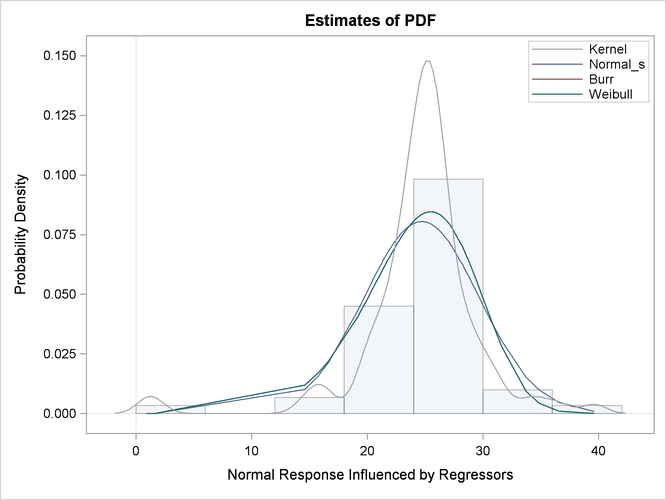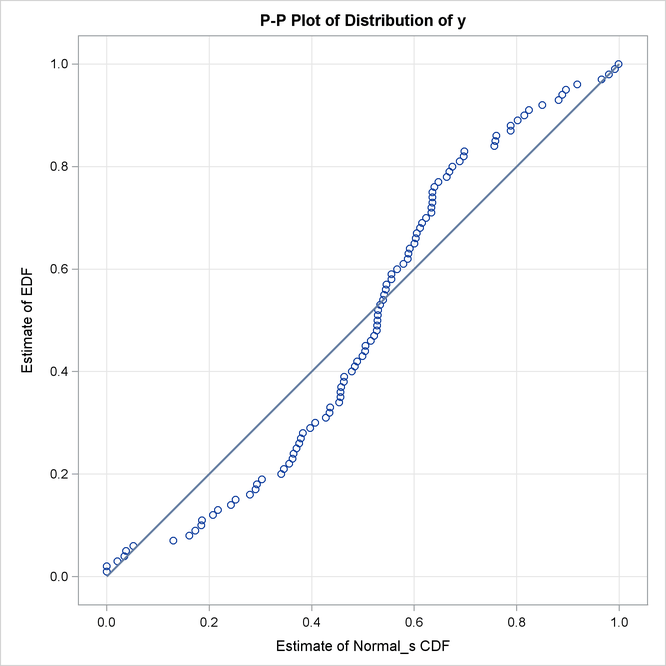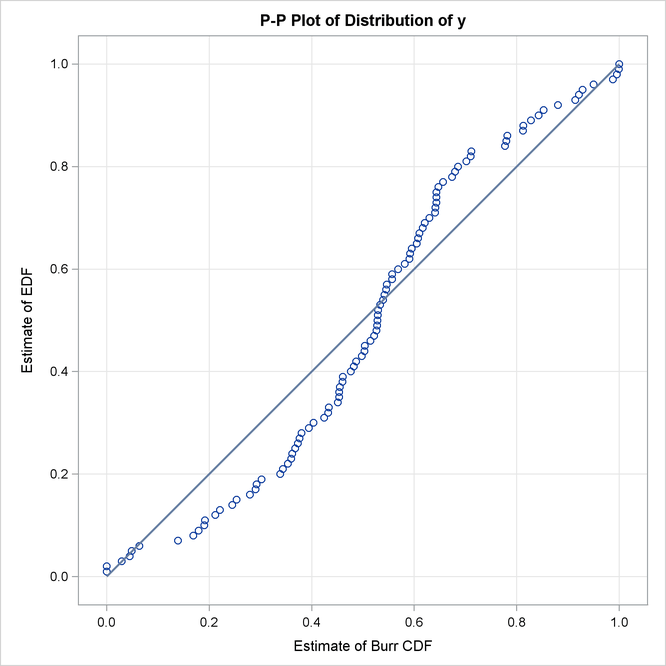The SEVERITY Procedure
- Overview
-
Getting Started

-
Syntax

-
Details
 Predefined DistributionsCensoring and TruncationParameter Estimation MethodParameter InitializationEstimating Regression EffectsEmpirical Distribution Function Estimation MethodsStatistics of FitDefining a Distribution Model with the FCMP ProcedurePredefined Utility FunctionsScoring FunctionsCustom Objective FunctionsMultithreaded ComputationInput Data SetsOutput Data SetsDisplayed OutputODS Graphics
Predefined DistributionsCensoring and TruncationParameter Estimation MethodParameter InitializationEstimating Regression EffectsEmpirical Distribution Function Estimation MethodsStatistics of FitDefining a Distribution Model with the FCMP ProcedurePredefined Utility FunctionsScoring FunctionsCustom Objective FunctionsMultithreaded ComputationInput Data SetsOutput Data SetsDisplayed OutputODS Graphics -
Examples
 Defining a Model for Gaussian DistributionDefining a Model for Gaussian Distribution with a Scale ParameterDefining a Model for Mixed-Tail DistributionsEstimating Parameters Using Cramér-von Mises EstimatorFitting a Scaled Tweedie Model with RegressorsFitting Distributions to Interval-Censored DataDefining a Finite Mixture Model That Has a Scale ParameterPredicting Mean and Value-at-Risk by Using Scoring Functions
Defining a Model for Gaussian DistributionDefining a Model for Gaussian Distribution with a Scale ParameterDefining a Model for Mixed-Tail DistributionsEstimating Parameters Using Cramér-von Mises EstimatorFitting a Scaled Tweedie Model with RegressorsFitting Distributions to Interval-Censored DataDefining a Finite Mixture Model That Has a Scale ParameterPredicting Mean and Value-at-Risk by Using Scoring Functions - References
If you want to estimate the effects of regressors, then the model needs to be parameterized to have a scale parameter. While
this might not be always possible, for the case of the Gaussian distribution it is possible by replacing the location parameter
![]() with another parameter,
with another parameter, ![]() , and defining the PDF (
, and defining the PDF (![]() ) and the CDF (
) and the CDF (![]() ) as follows:
) as follows:

It can be verified that ![]() is the scale parameter, because both of the following equalities are true:
is the scale parameter, because both of the following equalities are true:

Note: The Gaussian distribution is not a commonly used severity distribution. It is used in this example primarily to illustrate the concept of parameterizing a distribution such that it has a scale parameter. Although the distribution has a support over the entire real line, you can fit the distribution with PROC SEVERITY only if the input sample contains nonnegative values.
The following statements use the alternate parameterization to define a new model named NORMAL_S. The definition is stored
in the Work.Sevexmpl library.
/*-------- Define Normal Distribution With Scale Parameter ----------*/
proc fcmp library=sashelp.svrtdist outlib=work.sevexmpl.models;
function normal_s_pdf(x, Sigma, Alpha);
/* Sigma : Scale & Standard Deviation */
/* Alpha : Scaled mean */
return ( exp(-(x/Sigma - Alpha)**2/2) /
(Sigma * sqrt(2*constant('PI'))) );
endsub;
function normal_s_cdf(x, Sigma, Alpha);
/* Sigma : Scale & Standard Deviation */
/* Alpha : Scaled mean */
z = x/Sigma - Alpha;
return (0.5 + 0.5*erf(z/sqrt(2)));
endsub;
subroutine normal_s_parminit(dim, x[*], nx[*], F[*], Ftype, Sigma, Alpha);
outargs Sigma, Alpha;
array m[2] / nosymbols;
/* Compute estimates by using method of moments */
call svrtutil_rawmoments(dim, x, nx, 2, m);
Sigma = sqrt(m[2] - m[1]**2);
Alpha = m[1]/Sigma;
endsub;
subroutine normal_s_lowerbounds(Sigma, Alpha);
outargs Sigma, Alpha;
Alpha = .; /* Alpha has no lower bound */
Sigma = 0; /* Sigma > 0 */
endsub;
quit;
An important point to note is that the scale parameter Sigma is the first distribution parameter (after the 'x' argument) listed in the signatures of NORMAL_S_PDF and NORMAL_S_CDF functions. Sigma is also the first distribution parameter listed in the signatures of other subroutines. This is required by PROC SEVERITY, so that it can identify which is the scale parameter. When you specify regressor variables, PROC SEVERITY checks whether the first parameter of each candidate distribution is a scale parameter (or a log-transformed scale parameter if dist_SCALETRANSFORM subroutine is defined for the distribution with LOG as the transform). If it is not, then an appropriate message is written the SAS log and that distribution is not fitted.
Let the following DATA step statements simulate a sample from the normal distribution where the parameter ![]() is affected by the regressors as follows:
is affected by the regressors as follows:
The sample is simulated such that the regressor X2 is linearly dependent on regressors X1 and X3.
/*--- Simulate a Normal sample affected by Regressors ---*/
data testnorm_reg(keep=y x1-x5 Sigma);
array x{*} x1-x5;
array b{6} _TEMPORARY_ (1 0.5 . 0.75 -2 1);
call streaminit(34567);
label y='Normal Response Influenced by Regressors';
do n = 1 to 100;
/* simulate regressors */
do i = 1 to dim(x);
x(i) = rand('UNIFORM');
end;
/* make x2 linearly dependent on x1 and x3 */
x(2) = x(1) + 5 * x(3);
/* compute log of the scale parameter */
logSigma = b(1);
do i = 1 to dim(x);
if (i ne 2) then
logSigma = logSigma + b(i+1) * x(i);
end;
Sigma = exp(logSigma);
y = rand('NORMAL', 25, Sigma);
output;
end;
run;
The following statements use PROC SEVERITY to fit the NORMAL_S distribution model along with some of the predefined distributions to the simulated sample:
/*--- Set the search path for functions defined with PROC FCMP ---*/ options cmplib=(work.sevexmpl); /*-------- Fit models with PROC SEVERITY --------*/ proc severity data=testnorm_reg print=all plots=none; loss y; scalemodel x1-x5; dist Normal_s burr logn pareto weibull; run;
The “Model Selection Table” in Output 23.2.1 indicates that all the models, except the Burr distribution model, have converged. Also, only three models, Normal_s, Burr, and Weibull, seem to have a good fit for the data. The table that compares all the fit statistics indicates that Normal_s model is the best according to the likelihood-based statistics; however, the Burr model is the best according to the EDF-based statistics.
Output 23.2.1: Summary of Results for Fitting the Normal Distribution with Regressors
| Input Data Set | |
|---|---|
| Name | WORK.TESTNORM_REG |
| Model Selection | |||
|---|---|---|---|
| Distribution | Converged | -2 Log Likelihood |
Selected |
| Normal_s | Yes | 603.95786 | Yes |
| Burr | Maybe | 612.81685 | No |
| Logn | Yes | 749.20125 | No |
| Pareto | Yes | 841.07022 | No |
| Weibull | Yes | 612.77496 | No |
| All Fit Statistics | ||||||||||||||
|---|---|---|---|---|---|---|---|---|---|---|---|---|---|---|
| Distribution | -2 Log Likelihood |
AIC | AICC | BIC | KS | AD | CvM | |||||||
| Normal_s | 603.95786 | * | 615.95786 | * | 616.86108 | * | 631.58888 | * | 1.52388 | 4.00152 | 0.70769 | |||
| Burr | 612.81685 | 626.81685 | 628.03424 | 645.05304 | 1.50448 | * | 3.90072 | * | 0.63399 | * | ||||
| Logn | 749.20125 | 761.20125 | 762.10448 | 776.83227 | 2.88110 | 16.20558 | 3.04825 | |||||||
| Pareto | 841.07022 | 853.07022 | 853.97345 | 868.70124 | 4.83810 | 31.60568 | 6.84046 | |||||||
| Weibull | 612.77496 | 624.77496 | 625.67819 | 640.40598 | 1.50490 | 3.90559 | 0.63458 | |||||||
| Note: The asterisk (*) marks the best model according to each column's criterion. | ||||||||||||||
This prompts for further evaluation of why the model with Burr distribution has not converged. The initial values, convergence
status, and the optimization summary for the Burr distribution are shown in Output 23.2.2. The initial values table indicates that the regressor X2 is redundant, which is expected. More importantly, the convergence status indicates that it requires more than 50 iterations.
PROC SEVERITY enables you to change several settings of the optimizer by using the NLOPTIONS statement. In this case, you can increase the limit of 50 on the iterations, change the convergence criterion, or change
the technique to something other than the default trust-region technique.
Output 23.2.2: Details of the Fitted Burr Distribution Model
| Distribution Information | |
|---|---|
| Name | Burr |
| Description | Burr Distribution |
| Distribution Parameters | 3 |
| Regression Parameters | 4 |
| Initial Parameter Values and Bounds | |||
|---|---|---|---|
| Parameter | Initial Value |
Lower Bound |
Upper Bound |
| Theta | 25.75198 | 1.05367E-8 | Infty |
| Alpha | 2.00000 | 1.05367E-8 | Infty |
| Gamma | 2.00000 | 1.05367E-8 | Infty |
| x1 | 0.07345 | -709.78271 | 709.78271 |
| x2 | Redundant | ||
| x3 | -0.14056 | -709.78271 | 709.78271 |
| x4 | 0.27064 | -709.78271 | 709.78271 |
| x5 | -0.23230 | -709.78271 | 709.78271 |
| Convergence Status |
|---|
| Needs more than 50 iterations. |
| Optimization Summary | |
|---|---|
| Optimization Technique | Trust Region |
| Iterations | 50 |
| Function Calls | 137 |
| Log Likelihood | -306.40842 |
The following PROC SEVERITY step uses the NLOPTIONS statement to change the convergence criterion and the limits on the iterations
and function evaluations, exclude the lognormal and Pareto distributions that have been confirmed previously to fit the data
poorly, and exclude the redundant regressor X2 from the model:
/*--- Refit and compare models with higher limit on iterations ---*/ proc severity data=testnorm_reg print=all plots=pp; loss y; scalemodel x1 x3-x5; dist Normal_s burr weibull; nloptions absfconv=2.0e-5 maxiter=100 maxfunc=500; run;
The results shown in Output 23.2.3 indicate that the Burr distribution has now converged and that the Burr and Weibull distributions have an almost identical fit for the data. The NORMAL_S distribution is still the best distribution according to the likelihood-based criteria.
Output 23.2.3: Summary of Results after Changing Maximum Number of Iterations
| Input Data Set | |
|---|---|
| Name | WORK.TESTNORM_REG |
| Model Selection | |||
|---|---|---|---|
| Distribution | Converged | -2 Log Likelihood |
Selected |
| Normal_s | Yes | 603.95786 | Yes |
| Burr | Yes | 612.79276 | No |
| Weibull | Yes | 612.77496 | No |
| All Fit Statistics | ||||||||||||||
|---|---|---|---|---|---|---|---|---|---|---|---|---|---|---|
| Distribution | -2 Log Likelihood |
AIC | AICC | BIC | KS | AD | CvM | |||||||
| Normal_s | 603.95786 | * | 615.95786 | * | 616.86108 | * | 631.58888 | * | 1.52388 | 4.00152 | 0.70769 | |||
| Burr | 612.79276 | 626.79276 | 628.01015 | 645.02895 | 1.50472 | * | 3.90351 | * | 0.63433 | * | ||||
| Weibull | 612.77496 | 624.77496 | 625.67819 | 640.40598 | 1.50490 | 3.90559 | 0.63458 | |||||||
| Note: The asterisk (*) marks the best model according to each column's criterion. | ||||||||||||||
The comparison of the PDF estimates of all the candidates is shown in Output 23.2.4. Each plotted PDF estimate is an average computed over the ![]() PDF estimates that are obtained with the scale parameter determined by each of the
PDF estimates that are obtained with the scale parameter determined by each of the ![]() observations in the input data set. The PDF plot shows that the Burr and Weibull models result in almost identical estimates.
All the estimates have a slight left skew with the mode closer to
observations in the input data set. The PDF plot shows that the Burr and Weibull models result in almost identical estimates.
All the estimates have a slight left skew with the mode closer to Y=25, which is the mean of the simulated sample.
The P-P plots for the Normal_s and Burr distributions are shown in Output 23.2.5. These plots show how the EDF estimates compare against the CDF estimates. Each plotted CDF estimate is an average computed
over the ![]() CDF estimates that are obtained with the scale parameter determined by each of the
CDF estimates that are obtained with the scale parameter determined by each of the ![]() observations in the input data set. Comparing the P-P plots of Normal_s and Burr distributions indicates that both fit the
data almost similarly, but the Burr distribution fits the right tail slightly better, which explains why the EDF-based statistics
prefer it over the Normal_s distribution.
observations in the input data set. Comparing the P-P plots of Normal_s and Burr distributions indicates that both fit the
data almost similarly, but the Burr distribution fits the right tail slightly better, which explains why the EDF-based statistics
prefer it over the Normal_s distribution.


